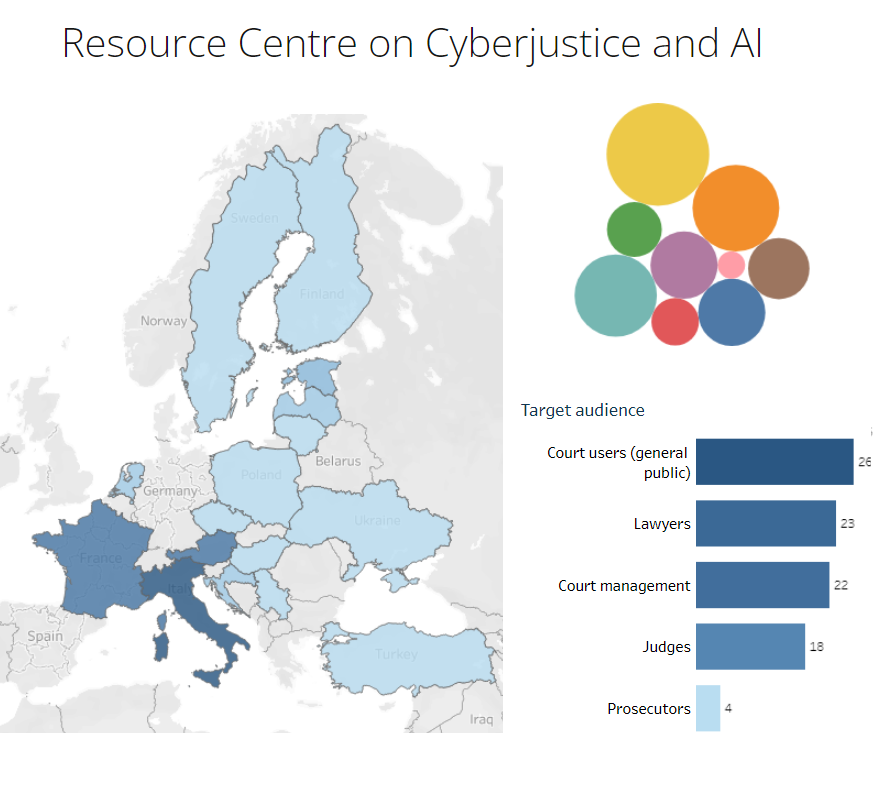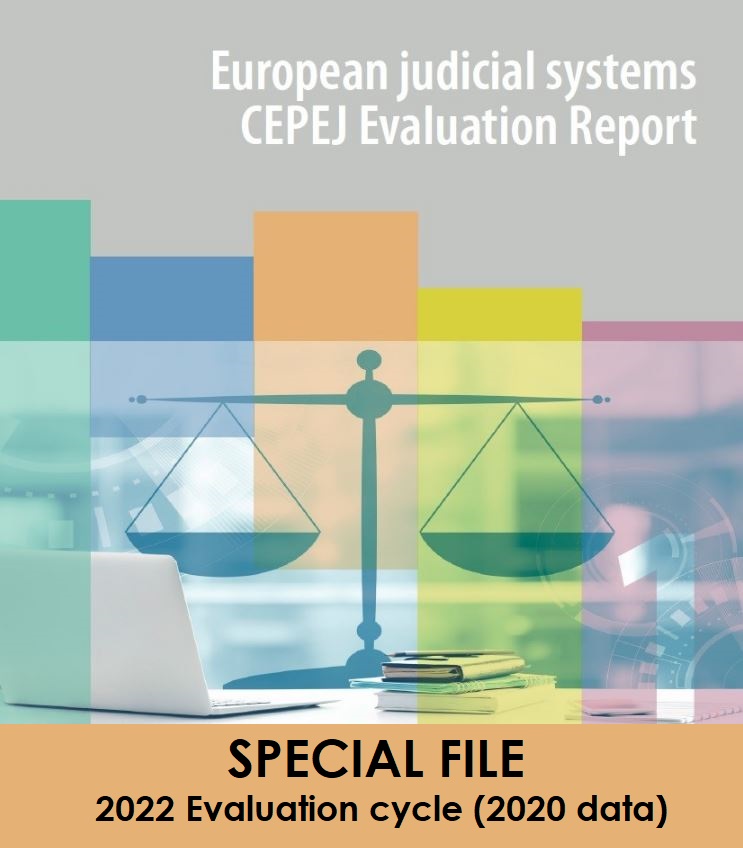Dynamic database of European judicial systems
Welcome to CEPEJ-STAT
This unique database allows you to find data related to judicial systems of Council of Europe Member states / entities and observers collected by the CEPEJ. These data, as well as the attached comments, are collected by the CEPEJ Secretariat already for many years via the network of National correspondents from Council of Europe member states as well as some observer countries.
The data presented are for the years 2010 to 2020, collected every two years.
To access to CEPEJ data, please select below one of the dashboards or explorers. A table of reference helps you navigate in these dashboards or explorers by describing the content of the chapters, groups of questions and type of data.
To guide you on the use CEPEJ STAT please consult the manual.
- Overview of judicial systems Provides the main indicators that are particularly important for observing overall performance of judicial systems and it is a good entry dashboard to discover CEPEJ-STAT and analyse together up to 5 countries.
- Efficiency Shows only indicators that measure efficiency of the court systems, in particular a Clearance Rate (CR) and Disposition Time (DT), as well as categories of efficiency.
- Budget Dashboard that focusses only on budgets of judicial systems and its components: budget of courts, prosecution service, and legal aid.
- Information and communication technology Dashboard where you may find indicators for measuring the level of development and use of ICT in courts including as well as ICT index per different categories
- Gender equality Dashboard that provides you a possibility to see the distribution male/female professionals by instance in different state/entity.
- (New) Judges and prosecutors Dashboard that provides different data on number of judges, prosecutors, non-judge staff and non-prosecutor staff and their ratios.
- Country profiles This dashboard presents a set of selected indicators and summary analysis on main elements of each judicial system.
- Search by topics (based on quantitative data) This explorer includes all numeric/quantitative data collected by CEPEJ that quantify different categories such as court case flow, budgets, number of judges, length of proceedings etc organised in topics and groups of questions with a defined hierarchy.
- Variation of quantitative data This explorer offers you a possibility to follow trends for quantitative data from year to year and see variations over selected periods of time and includes same numeric data as in the “Quantitative data and the same hierarchy of organisation.
- Search by topics (based on qualitative data) All qualitative data from the CEPEJ data collection are included in this explorer. These data relate to different aspects of the judiciary that describe the system, such as list of competencies of certain institutions, list of procedures available in the courts etc. It use the same hierarchy of organisation as the previous explorers.
- Search by question numbers or CEPEJ questionnaire keys words This explorer is mostly suited for people familiar with the CEPEJ questionnaire numbering since the search for all countries and all years can be done by question number or questionnaire key word.
- Reforms planned for judicial systems This explorer gives a possibility to see status and details of the reform plans for different member States and entities as well observer countries as presented by them in the last evaluation cycle.
The CEPEJ, which attaches the utmost importance to the quality of its data, stresses the need to respect the methodology for using such data. In this respect, we remind you that CEPEJ data can only be used and understood in combination with the comments (metadata) provided by the national correspondents during data collection and quality control. When CEPEJ data are used, please quote the source, in particular when data from other sources are used simultaneously.
The data presented in the database are collected through a questionnaire, from the network of national correspondents of the CEPEJ. Special efforts have been made to define the terms used and to ensure that the concepts are aligned according to a common understanding. The confirmation of the data has been done according to a rigorous quality control methodology and the CEPEJ has chosen to present only the data that offered a high level of quality and reliability.
The collection of data aims to give an overview of the situation of the European judicial systems, and not to rank the best judicial systems in Europe, which would be scientifically inaccurate and would not be a useful tool for the public policies of justice. The comparison of data must be approached with great caution by the readers who consult the report or CEPEJ-STAT, interpret the data and analyse the information it contains and should take into account in particular the characteristics of the judicial systems (e.g. civil law and common law countries; countries with relatively new or newly reformed judicial systems or countries with old judicial traditions), geographical criteria (size, population) or economic criteria (for instance, size of GDP; within or outside the Euro zone, etc.).
In case the data available online are not sufficient for your analysis due to the existing format or the quantity, please take note of the following : Protocol for the transmission and use of CEPEJ data.
Specific Studies of the CEPEJ on the Legal Professions – 2020 data
The comparison of quantitative data from different countries with various geographical, economic and legal situations is a delicate task. It should be approached with great caution by the readers consulting the report or CEPEJ STAT, interpreting data, and analysing the information.
In order to compare the various states and their systems, the particularities of the systems, which might explain differences in data from one country to another, must be borne in mind (different judicial structures, the way of the courts organisation, use of statistical tools to evaluate the systems, etc.). Special efforts were made to define the used terms and to ensure that the concepts are addressed according to a common understanding. However, the particularities of some systems might prevent to identify common trends. In this case, the comments to the data are to be consulted. Therefore, only an active reading of this report can allow analyses to be made and conclusions to be drawn. Moreover, figures cannot be taken for granted but must be interpreted by the light of the accompanying comments.
The collection of data aims to give an overview of the situation of the European judicial systems, and not to rank the best judicial systems in Europe, which would be scientifically inaccurate and would not be a useful tool for the public policies of justice. Indeed, comparing does not mean ranking. However, the presentation of data gives tools for an in-depth study which would then have to be carried out by choosing relevant clusters of countries: according to the characteristics of the judicial systems (for instance civil law and common law countries; countries with relatively new or newly reformed judicial systems or countries with old judicial traditions), geographical criteria (size, population) or economic criteria (for instance size of GDP; within or outside the Euro zone, etc.).
The CEPEJ scheme was also filled in by certain small states. Andorra and Monaco are territories which do not operate on a comparable scale to the other states surveyed in the report. Therefore must the figures of these states be interpreted cautiously, taking into account the specificities of the national structural indicators.
Monetary values are reported in Euros. For that reason, using exchange rates for states outside the Euro zone caused some difficulties. Exchange rates can actually vary a lot from year to year. The high variation of the exchange rate might have a considerable effect on the figures for the countries outside the Euro zone.
In case the data available online is not sufficient for your analysis due to the existing format or the quantity, please take note of the following protocol to obtain an access to raw data: Protocol for the transmission and use of CEPEJ data.
- NA: Data not provided by the State (Non available).
- NAP: This data is not applicable to the State.
- CR: Clearance Rate, ratio between resolved cases and incoming cases (in %).
- DT: Disposition Time, ratio between pending cases and resolved cases (in days). It shows the theoretical duration for a court to solve all the pending cases.
- OTC: Other Than Criminal cases, applicable to the questions about efficiency (number of cases, etc).
Collaborative workspaces:






